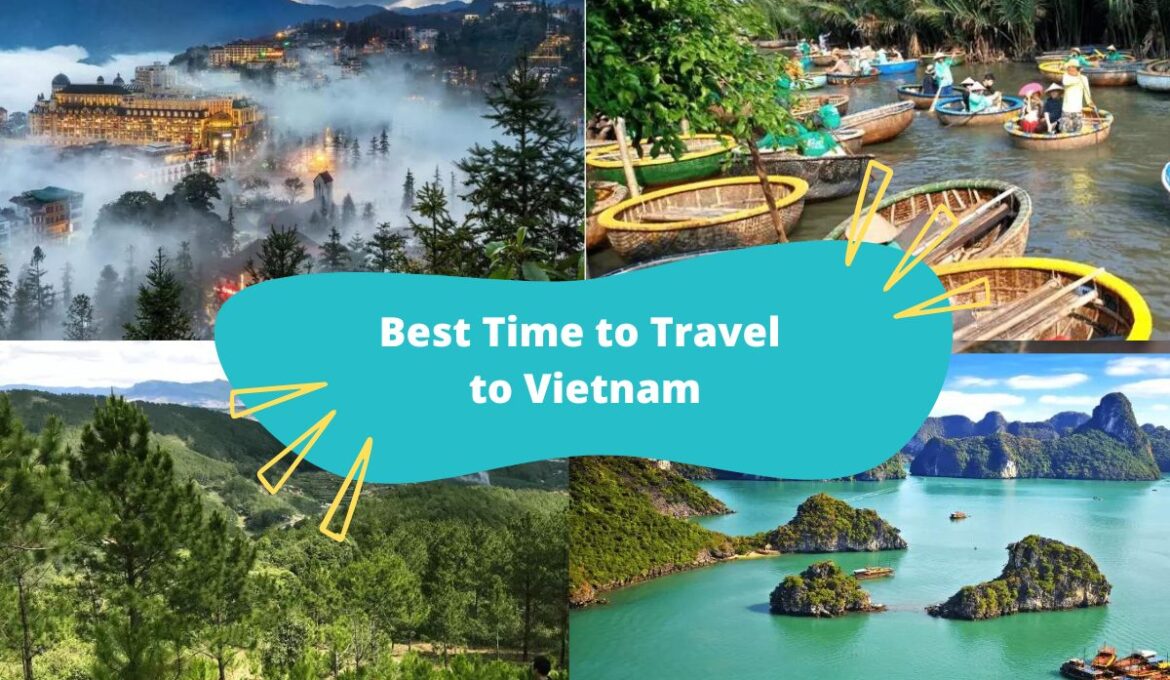
Best Time to Visit Vietnam: A detailed weather guide
- on Dec 29, 2017 By: Ngoc Tu DINH
For tourists intending to explore Vietnam, especially those visiting Vietnam for the first time, “How is the weather in Vietnam?” “When should I visit Vietnam?” and “When is the best time to visit Vietnam?” are among the most commonly asked questions.
Indeed, the weather is an important factor to consider when traveling. This guide, developed by Authentik Vietnam, provides tips for choosing the best time to visit Vietnam based on your climate preferences and planned activities
Vietnam’s climate and weather by regions
With its territory extending from North to South, Vietnam presents a great climatic diversity influenced by its geographical position and topography. Each region – the North, Center, and South – offers a unique climate and varied tourist experiences throughout the year.
Weather in North Vietnam
Northern Vietnam comprises major cities such as Hanoi, Ninh Binh, Ha Long, Mai Chau, Pu Luong, as well as mountainous northeastern provinces such as Ha Giang, Cao Bang, and Bac Kan, which are located at the highest latitudes in the country. There is also the northwest region, home to Nghia Lo, Tu Le, Mu Cang Chai, Sapa, and Bac Ha. The North Of Vietnam is characterized by a tropical monsoon climate with four distinct seasons: spring (February-May), summer (June-August), autumn (September-November), and winter (December-January).
Due to its location close to the Northern Tropic and its mountainous terrain, the North of Vietnam is subject to significant climatic variations. Summers are hot and rainy, dominated by the southwest monsoon, which brings abundant rainfall. Winters, on the other hand, are cold and dry under the influence of the northeast monsoon winds, which can sometimes cause significant drops in temperature, especially in mountainous regions.
The North is particularly popular with tourists between October and April, the ideal period from late autumn to spring. During this time, the weather is mild and pleasant, perfect for exploring picturesque landscapes such as Ha Long Bay, the rice terraces of Sapa, or Hanoi's historic sites.
Weather in Central Vietnam
Central Vietnam, covering Phong Nha-Ke Bang to Hue, Hoi An, Da Nang, Quy Nhon, and Nha Trang, is marked by the Hai Van Pass, which separates the northern climate from that of the south. The varied topography of this region, with coastal areas and mountains, is the reason for significant climatic differences.
Coastal cities benefit from a more moderate climate and maritime influences, ensuring more stable temperatures throughout the year. However, mountainous regions can experience cooler temperatures and heavier rainfall. The rainy season is concentrated mainly in October and November, when storms and heavy rain can occur, making some areas difficult to visit.
Apart from these rainy months, Central Vietnam is ideal for tourism. The beaches of Nha Trang and Da Nang, the cultural heritage of Hue and Hoi An, and the spectacular caves of Phong Nha-Ke Bang attract visitors all year round. The months of April to September, with their sunny days, are particularly good for beach activities and sightseeing in this part of Vietnam.
Weather in South Vietnam
Southern Vietnam, consisting of Ho Chi Minh City, the Mekong Delta, and the heavenly beaches of Con Dao,Phu Quoc, and Phan Thiet, is located near the equator and enjoys a humid tropical climate. This region is characterized by two distinct seasons:thedry season (November-April) and the rainy season (May-October). During the dry season, temperatures vary between 25°C and 35°C with sunny days and little rainfall, providing ideal conditions for exploring the floating markets of the Mekong Delta or relaxing on the beaches. The rainy season, on the other hand, is marked by frequent, intense, but generally short showers, contributing to the lush green landscapes. Geographically, the region's proximity to the equator means that there is little seasonal variation in temperature, but abundant rainfall has a strong influence on daily life and farming activities in the region. This humid tropical climate, with its two well-defined seasons, shapes the unique visitor experience, combining constant warmth with lush nature.
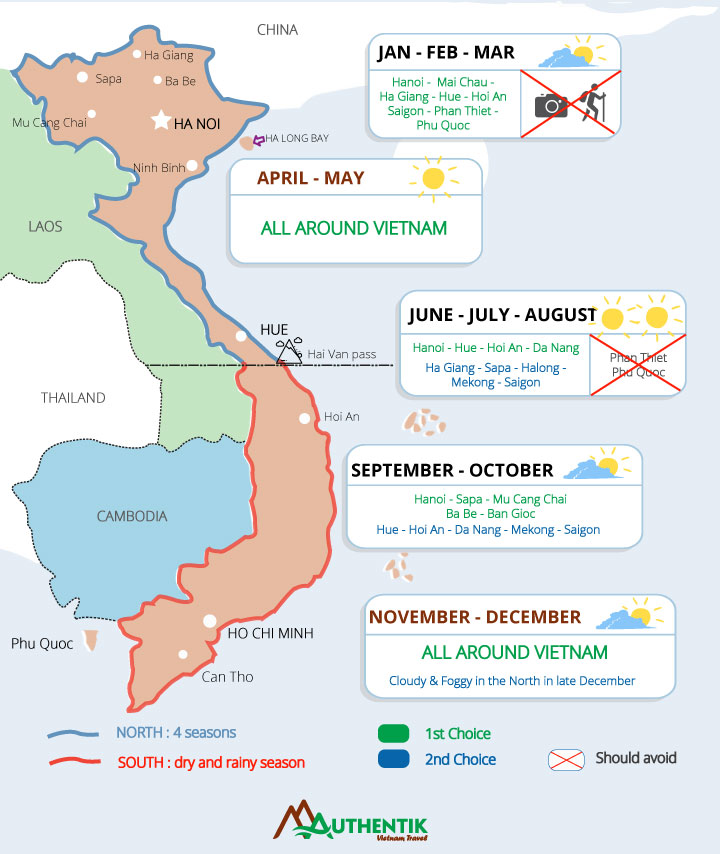
Where and when to travel to Vietnam
Each region in Vietnam offers a unique experience owing to its varied climates and diverse landscapes. Whether you're drawn to the charm of the North, the sunny beaches of the Center, or the constant warmth of the South, Vietnam has something to offer every traveler. Here are some recommendations to better understand the climate depending on the month, as well as to identify the ideal activities for each period.
Travel to Vietnam in January and February
While winter persists in the North with cold and foggy weather, especially in the mountainous areas, the weather in the Central region during January and February is ideal for outdoor activities. As for the South, the region benefits from a sunny and dry climate, perfect for beach outings.
Weather and where to visit in Vietnam in January-February
During the first two months of the year, the Northern region of Vietnamis covered in the cold of winter. This is a good time to explore the picturesque landscape of Ha Long. Even though many aquatic activities such as swimming and kayaking can be refrained due to the cold waters, a cruise on Ha Long Bay still promises to be an unforgettable experience, as the fog adds a touch of magic, bringing a mystical vibe to the bay. Visits to historical and cultural sites in Hanoi and Ninh Binh benefit from the unique atmosphere owing to the chilly weather. Trekking enthusiasts will find the cooler weather perfect for exploring the scenic northeastern or Mai Chau-Pu Luong regions. Sapa, however, is not advisable due to the dense fog, which limits visibility and adventurous activities.
In Central Vietnam, the mild weather with low precipitation during January and February creates ideal conditions for outdoor activities and cultural visits, such as exploring the Hue Imperial City, the royal tombs, or strolling through the charming streets of Hoi AnAncient Town, a UNESCO World Heritage Site. Though the water might be a bit chilly, the beaches of Da Nang and Hoi An promise a magnificent getaway with stunning landscapes in which to relax and soak up the sun. For adventurous travelers, Phong Nha-Ke Bang National Park in Quang Binh is ideal to head to.
In the South of Vietnam,during January and February, the weather is warm and sunny with low rainfall, making it the perfect time to enjoy the seaside resorts in Phu Quoc, Con Dao, Mui Ne, Nha Trang,... and other open-air activities. Featuring sunny skies and turquoise waters, these destinations are excellent for relaxing, swimming, and water sports. This is also an ideal period to embark on a river cruise in the Mekong Delta and explore this region's floating markets, lush orchards, and green landscapes.
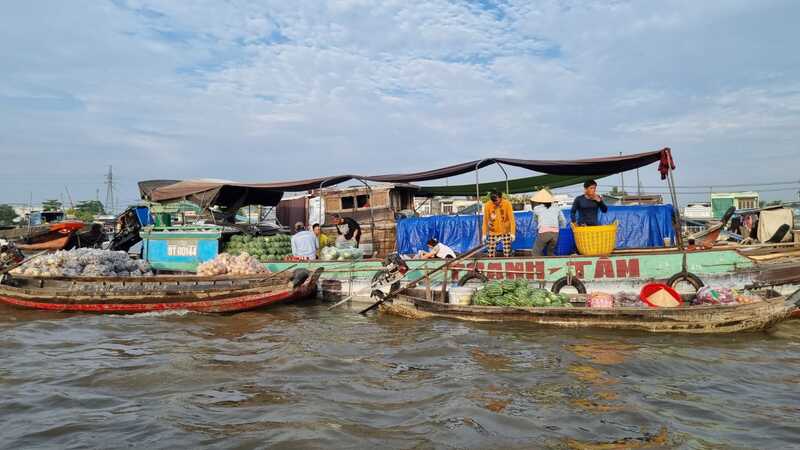
A typical day at Cai Rang Floating Market
Regional festivals to discover
In Vietnam, the period of January- February is when many traditional festivals occur, making this time an ideal occasion for tourists to learn more about the local culture.
Tet Nguyen Dan (Vietnamese Lunar New Year)
Marking the start of a new lunar year, Tet Nguyen Dan is the most important festival in Vietnam. This is a time of renewal and purification, when families gather to honor their ancestors, exchange wishes for prosperity and happiness, and participate in various traditions such as cleaning houses, decorating with Tet’s signature ornamental plants, and preparing Tet’s typical dishes. The Vietnamese Lunar New Year in 2025 will fall on January 29th.
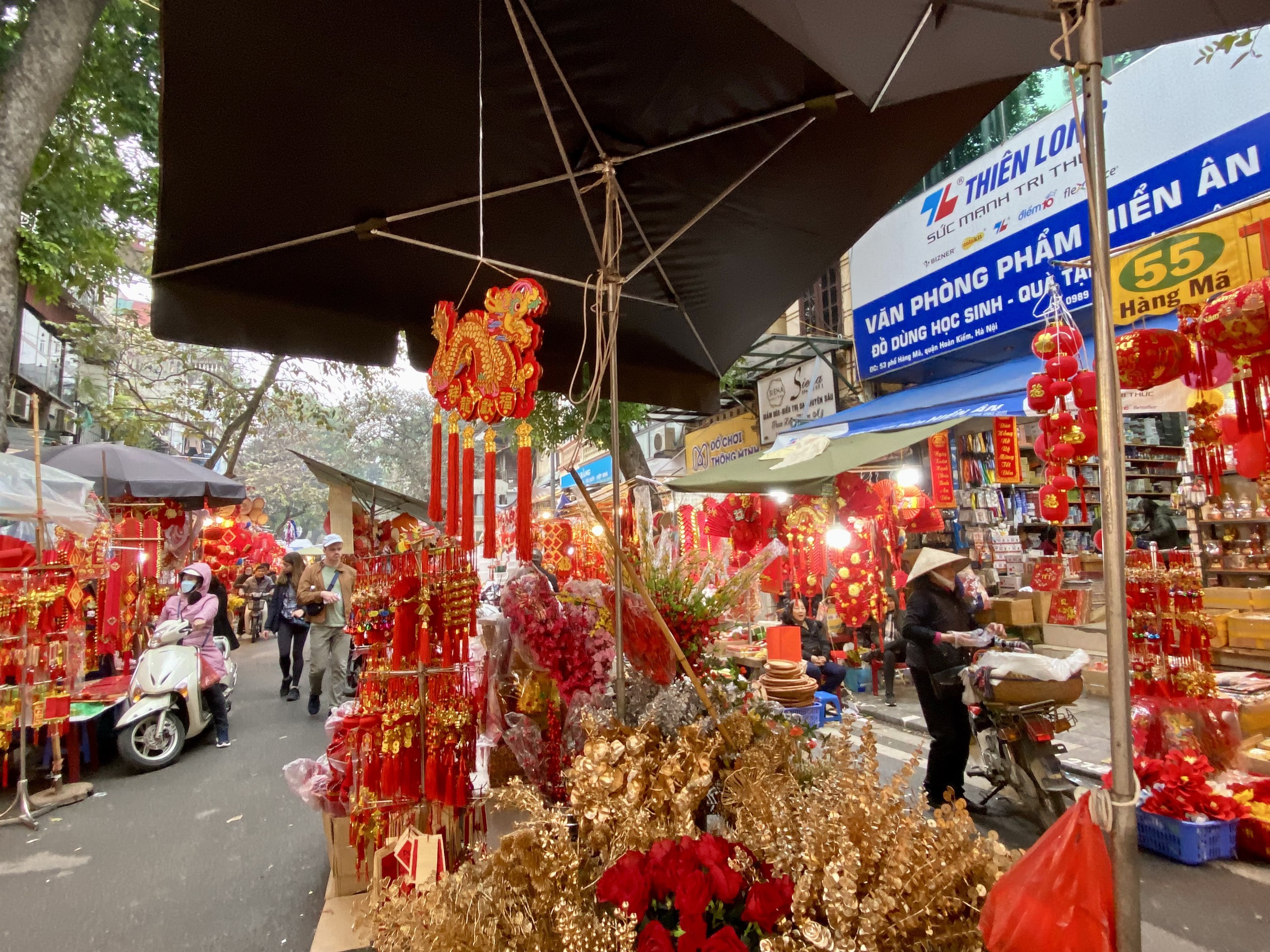
Hang Ma Street in Hanoi in preparation for Tet
Chua Huong Festival (Perfume Pagoda Festival)
This festival kicks off on the 6th day of the first lunar month and lasts until the end of the third lunar month at Perfume Pagoda in the suburbs of Hanoi. Being one of Vietnam's most significant Buddhist festivals, every year the Chua Huong festival draws thousands of pilgrims who come to pray for health, happiness, and prosperity. This festival includes religious ceremonies, processions, and traditional performances.
Giong Festival
On the 6th day of the first lunar month, the Giong Festival takes place yearly at the Giong Temple in Hnaoi’s Soc Son district. The festival commemorates Giong, a legendary hero who is believed to have protected Vietnam from foreign invaders. Processions, battle re-enactments, and worship offerings are all part of the festivities.
Lim Festival
The Lim Festival is held every 13th day of the first lunar month at Lim Village, Bac Ninh Province. Renowned for Quan Ho singing, a type of Vietnamese folk music, this festival celebrates love and folk culture, with participants singing traditional Quan Ho songs in colorful costumes.
Yen Tu Festival
The Yen Tu Festival, which begins on the 10th day of the first lunar month on Yen Tu Mountain in Quang Ninh Province, is a major Buddhist pilgrimage during which devotees climb the mountain to visit pagodas and temples. The festival honors Buddha and the founders of Vietnamese Zen.
Important information for tourists
Holidays: During Tet, Vietnamese people have a week-long holiday, which means that most shops and services, especially in the northern part of the country, are unavailable. Because of this, service charges tend to increase, leading to a significant addition to the travel budget.
Transport booking: When traveling between Ho Chi Minh City and Hanoi, it's recommended to book flights and train tickets in advance. Demand for flights and trains from Ho Chi Minh City to Hanoi before Tet, and from Hanoi to Ho Chi Minh City after Tet, is especially high. Therefore, it's best to make your bookings as early as possible to secure your travel plans.
Service quality: The quality of services before and after Tet might be rather less reliable. Before Tet, the atmosphere is hustling and bustling with preparations for the festival, while during Tet, the streets are quieter as Vietnamese gather with their families. After Tet, it’s time for spring excursions and festivals. Therefore, it would be ideal to plan your trip before or after Tet to fully appreciate the festive atmosphere.
Accommodation: Opting for a homestay can be a great way to experience Tet alongside the locals and discover traditions authentically.
Traditional markets: In North Vietnam, Tet markets generally open until New Year’s Eve (the 30th of the last lunar month of the old year, also known as 30 Tet). However, markets in mountainous regions close at 30 Tet and remain closed until the end of the first lunar month. As for the southern region, the floating markets cease their Tet activities on the 28th of the last lunar month and resume after the 5th of the first lunar month. It is therefore important to plan your visits around these dates.
Pilgrimage sites and festivals: If you don't like crowds, avoid popular pilgrimage and festival sites, especially on weekends. Be mindful that attractions such as Perfume Pagoda and Ninh Binh tend to be extremely crowded.
Mountainous regions: For those planning to head to the mountainous regions during this time, don't forget to pack warm clothing as the temperatures can drop significantly.
Travel to Vietnam in March and April
In March and April, Vietnam benefits from pleasant weather in all three main regions.
Spring has arrived in the north, characterized by a cool, pleasant climate. The drizzles of February are over, giving way to fine, bright weather. In the center, the weather remains ideal for outdoor activities. The same is true for the south, where the dry season continues, marked by comparatively hot and dry weather.
Climate and where to visit in Vietnam in March-April
This period marks the peak tourist season for foreign visitors, owing to favorable weather conditions throughout the country.
The months of March and April are unquestionably the best times to visit Vietnam, as this period allows tourists to visit Vietnam’s main attractions from north to south without being hampered by bad weather. Whether it’s Hanoi, Hue, Da Nang, or Ho Chi Minh City, each destination offers a unique experience.
A cruise on Ha Long Bay is highly recommended at this time of the year. The weather is sunny and bright, but not yet too hot, providing a pleasant and memorable experience at this must-visit destination in Vietnam.
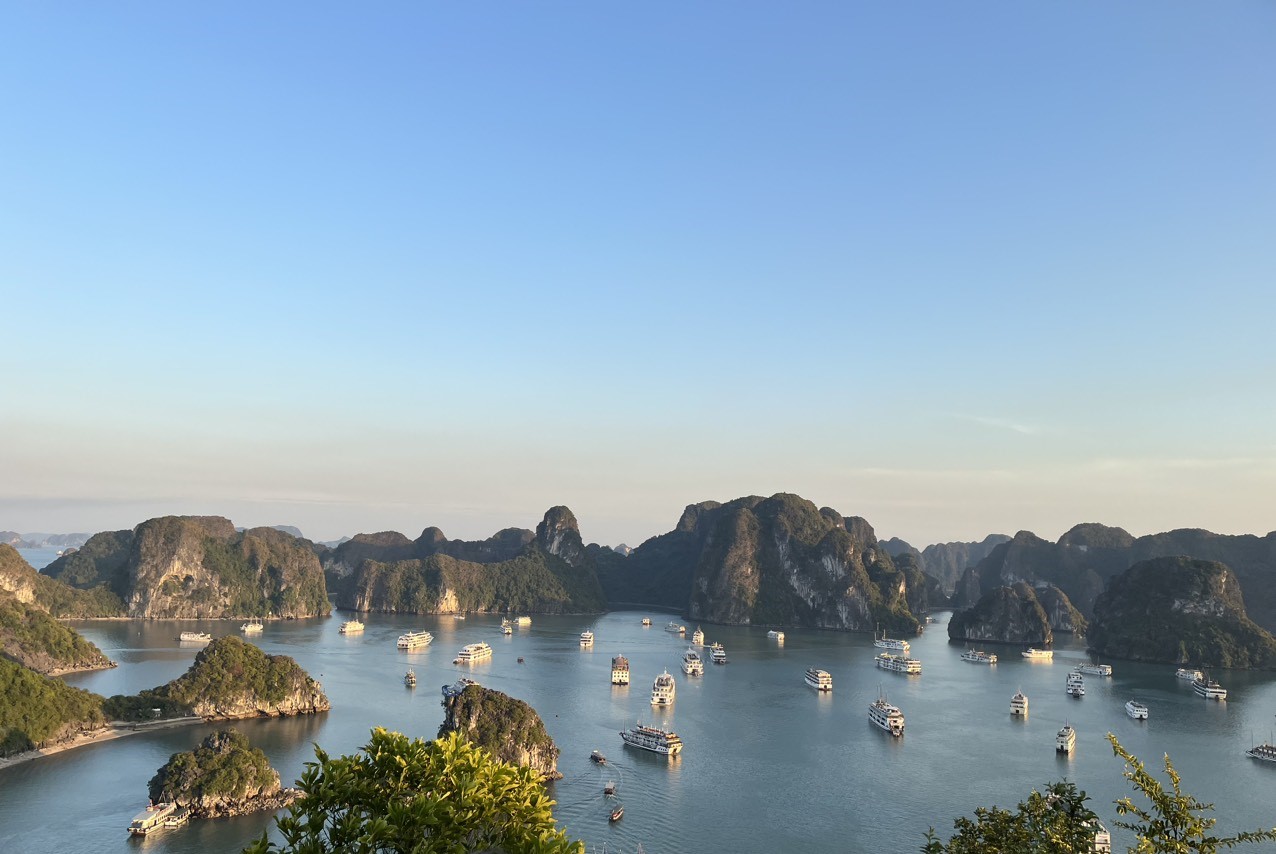
Halong Bay
The climate is also perfect for trekking enthusiasts, especially in the north. At this time of the year, rice fields in Mai Chau, Pu Luong, and mountain valleys such as Nghia Lo, Tu Le, and Ha Giang are already planted, offering lush green landscapes. The sights in the northeastern regions, such as Ha Giang, Cao Bang, and Ba Be, are also beautiful at this time of the year. However, Mu Cang Chai and Sapa do, as yet, not have their terraced rice fields planted at this moment of the year due to the lack of water for the plantation. In the center and the south, some regions are also suitable for trekking, offering diverse landscapes and unique experiences.
Regional festivals to discover
The period from March to April is when various traditional festivals take place in different parts of the country. While they are often local in scope, these festivals offer an authentic immersion in Vietnamese culture.
Thay Pagoda Festival
This festival, on the 7th day of the 3rd lunar month at the Thay Pagoda on the outskirts of Hanoi, honors Tu Dao Hanh, a Buddhist famous for his powers of healing and miracles. Celebrations include water puppet shows, processions, and prayers.
Hung King Temple Festival
Held annually on the 10th day of the 3rd lunar month in Phu Tho Province, this national festival is to commemorate the Hung Kings, the legendary founders of Vietnam. Ceremonies include solemn processions, traditional dances, and offerings to ancestors.
Ba Trieu Temple Festival
The Ba Trieu Temple Festival is held on the 21st day of the 2nd lunar month in Thanh Hoa to pay tribute to a national heroine who led a revolt against Chinese invaders in the 3rd century. The festivities include commemorative ceremonies, traditional dances, and games.
Helpful Travel Tips for Visitors to Vietnam in March-April
Since March and April coincide with peak tourist season, booking your flight tickets, accommodations, tour guides, and other services in advance is crucial.
Flight tickets: Book international and domestic flights several months in advance to get the best fares and avoid sold-out situations.
Accommodations: Hotels, homestays, and other types of accommodation tend to book up quickly; hence, plan ahead and book early to guarantee your place and benefit from the best rates.
Guides and excursions: Tour guides and nice excursions are likely to be booked weeks in advance, especially in popular attractions. Make sure to plan your activities and book as soon as possible.
Local transport: If you plan to travel between different regions in Vietnam by plane, train, or bus, book your tickets in advance to avoid inconvenience.
Travel to Vietnam in May and June
If you wish to avoid the tourist crowds of March-April and enjoy more space and tranquility, May-June is the ideal time for your trip.
The summer arrives in the North, bringing warm temperatures. Rainfall remains low, and there are no storms yet. Since the skies are clear, it is ideal for admiring the stunning sunrises and sunsets over Ha Long Bay.
The Central experiences an increase in temperature but has not yet reached the summer heat peaks. Rain is still infrequent, meaning relatively pleasant conditions for visits.
As for the southern part of the country, the rainy season begins, characterized by hot temperatures and frequent showers in the late afternoon. Though the rain is generally short, it is a good idea to keep an umbrella handy in case of sudden showers.
Climate and where to visit in Vietnam in May-June
Despite the heat in all parts of Vietnam, it is still possible to make the most of sightseeing in May and June. Historical and cultural sites offer rewarding exploration for travelers. For photography enthusiasts, this is the right time for stunning works of art, owing to the spectacular landscapes. While the golden rice terraces in Mu Cang Chai and Sapa offer picturesque scenes, harvesting activities in the Red River Delta, Mai Chau, and Pu Luong enliven the landscapes. The clear skies also offer unforgettable sunrises and sunsets over Ha Long Bay, giving magical moments for photographers and visitors alike.
The weather conditions favor trekking in northern Vietnam. The valleys offer striking visual spectacles, owing to the golden rice paddies ready to be harvested. In Mu Cang Chai and Sapa, the local's irrigation of the rice fields is a fascinating sight to witness, as it showcases centuries-old farming traditions in a majestic mountain setting. In the northeast, the cool climate is ideal for memorable treks through lush, rolling landscapes, offering visitors a total immersion in natural beauty and local culture.
Since the rainy season has arrived, heading to beaches in southern Vietnam during this time is not recommended. Instead, travelers should opt for beaches in the central, such as Hue, Hoi An, Quy Nhon, and Phu Yen, where the conditions are ideal for making the most of the calm sea and relaxing by the water, away from the hustle and bustle of the popular tourist areas.
Fine weather and calm waters make Ha Long Bay a must-see destination, as does a cruise in this breathtaking natural setting. The conditions favor boat trips through the famous karst islands, discovering hidden caves and fascinating rock formations, and swimming in the emerald waters of this UNESCO World Heritage bay. Each cruise offers a unique opportunity to embrace nature and appreciate the splendor of Ha Long Bay, creating lasting memories of a trip to Vietnam.
Regional festivals to discover
The months of May and June are great times to discover Vietnam, with a variety of cultural events and favorable conditions for travelers.
In May, the Hue Festival is a major event that immerses visitors in Vietnamese culture. Celebrating Hue, the former imperial capital of Vietnam, the festival is known for colorful parades, traditional performances, and exhibitions of local crafts. During one week of the festival, the streets come alive with folk dances and displays of ancient crafts, providing a captivating immersion in Vietnamese history and culture.
Held in early June, the Tam Coc Trang An Golden Season Festival in Tam Coc is a unique celebration of the rice terraces of this picturesque region. Located in Ninh Binh province, Tam Coc is renowned for its spectacular karst landscapes and winding rivers lined with rice paddies, which form an excellent natural setting for cultural events such as open-air theatre performances and traditional Vietnamese music concerts.
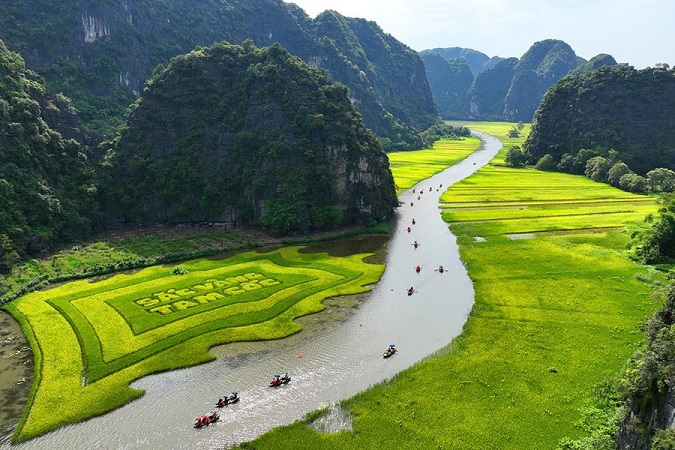
Tam Coc, Ninh Binh or Halong Bay on land
In Ho Chi Minh City, the Southern Fruit Festival, also in June, showcases the richness and diversity of Vietnamese tropical fruit. Visitors can browse exhibitions featuring a host of exotic fruits, sample tastings, and learn the secrets of Vietnam’s fruit growing.
Helpful Travel Tips for Visitors to Vietnam in May and June
During the April 30–May 1 holiday, it is advisable to avoid popular tourist attractions such as Cat Ba, Ninh Binh, Hoi An, and Sapa, as these destinations might witness overcrowding, traffic jams, and an increase in service charges due to the large numbers of Vietnamese coming for vacations. For a more relaxing and peaceful experience, plan your trip and activities outside these dates or opt for less popular locations.
Weekends too attract local crowds to Vietnam’s beaches. Therefore, it is recommended to opt for weekday beach visits. Central beaches such as Hue, Hoi An, Quy Nhon, and Phu Yen provide the perfect elements for a seaside vacation with their clear waters and tranquil beaches, which are excellent for swimming and water activities.
Travel to Vietnam in July and August
In July and August, the three regions of Vietnam experience climatic conditions.
This is the hottest time of the year in North Vietnam, with temperatures ranging from 30oC to 36oC. This time also marks the beginning of rainy and typhoon season in this region, characterized by short-lived showers that cool the atmosphere. About 1-2 typhoons can be expected every month.
In the Centre of the country, temperatures rise extremely high, varying between 34oC and 37oC with little rainfall.
Meanwhile, the South experiences regular showers keeping the climate humid and hot as the rainy season persists.
Where to visit in Vietnam in July- August?
For those planning a trip to Vietnam in July and August, here is a detailed selection of recommended activities, taking into account the varied seasonal weather conditions and popular attractions.
Despite the sweltering summer heat, tourist activities remain possible in all regions. This period attracts many families on vacation, creating a lively and jubilant ambiance at popular tourist sites. Most historical and cultural attractions, such as the Temple of Literature in Hanoi, the Imperial City of Hue, and Hoi An Ancient Town, welcome thousands of visitors with fascinating stories and architecture.
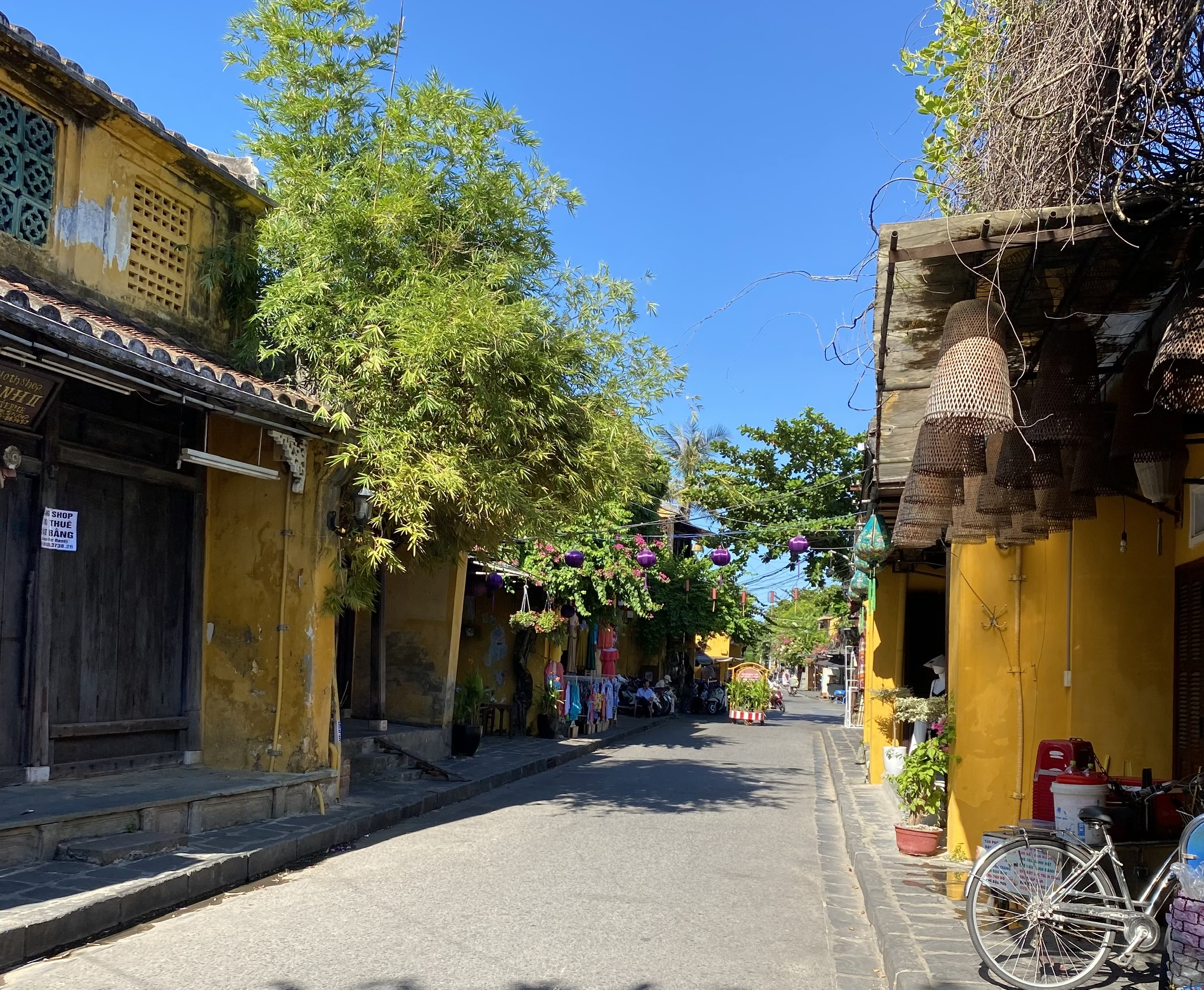
A corner of Hoi An on a sunny day in July
The North of Vietnam, especially in the mountainous regions around Sapa and the Northwest, showcases the fascinating landscapes of verdant rice terraces. July and August are the ideal times for trekking as the rice paddies begin to ripen, painting the hills in brilliant green and offering spectacular views to trekkers. The indigenous ethnic villages add an authentic ambiance to the local cultural immersion.
The Center provides optimal conditions for relaxing by the beaches of Da Nang, Hoi An, Hue, Quy Nhon, and Nha Trang. Visitors can enjoy swimming, snorkeling, and other water sports under sunny skies and pleasant temperatures in unspoiled natural settings. As opposed to the beaches of the center, those of the south can be affected by heavy rain during this period, imposing certain limitations on beach vacations and outdoor activities.
Despite the occasional risk of storms, Ha Long Bay remains a must visit cruising destination. The iconic karst formations, mysterious caves and emerald waters make it a magical place to explore. Travelers are advised to check the weather forecast regularly and plan their cruise accordingly to avoid any cancellations due to adverse weather conditions.
Festivals and Helpful Travel Tips for Visitors to Vietnam in July and August
Around this period, Vietnam celebrates several traditional festivals, including the Mid-Autumn Festival on different dates according to the lunar calendar. This festival is particularly popular among Vietnamese families, attracting many local visitors to major tourist destinations such as Hanoi and Hội An. It offers an excellent opportunity to discover Vietnamese culture through lantern shows, folk dances, and regional culinary specialties.
Avoid crowds: Given that July and August are holiday months for large numbers of Vietnamese, tourist attractions such as Cat Ba and Da Nang are likely to experience heavy crowds, especially on weekends. Foreign visitors are advised to plan their visits to popular sites on weekdays to avoid crowds and price increases.
Advanced bookings: To guarantee availability and benefit from the best rates, it is advisable to book your accommodation, guided tours and transport in advance. This is particularly crucial during the peak tourist season, when services can be booked up quickly, especially in popular locations such as Ha Long Bay and Sapa.
Flexibility in scheduling: Considering the possibility of changing weather conditions, especially with typhoon season in the north, it's essential to be flexible in your planning. Having alternatives ready in case plans change is recommended, for example substituting a cruise to Ha Long with a cultural exploration in Hanoi or a scenic visit to Ninh Binh.
Travel to Vietnam in September
September presents an ideal time to visit Vietnam, given the favorable meteorological conditions throughout the country.
In the North, autumn arrives, bringing sunny days and cooler temperatures compared to the previous months. The risk of typhoons is low, allowing safe exploration in the region.
In the Center, the climate is characterized by little rain, excellent for visiting destinations such as Hue, Da Nang, and Hoi An, as these cities offer perfect conditions for beach getaways and cultural explorations without being disrupted by showers.
In the South, the rainy season finally starts to come to an end, giving way to sunny days punctuated by occasional rains. Thus, this is the ideal time to explore coastal regions such as Phan Thiết and Vũng Tàu, which are less affected by the season's inclement weather.
What to visit in Vietnam in September?
In Vietnam, September favors various types of travel. Take advantage of the lingering warmth in the mild weather to explore the iconic attractions of the country. Trekking and photography enthusiasts will be delighted in the mountainous northern regions such as Sapa and the northwest, where the rice terraces reach their peak of beauty during the harvest, offering spectacular vistas to capture unforgettable moments. For those seeking seaside relaxation, the tranquil beaches of Vietnam's central coast, such as Huế, Đà Nẵng, Hội An, and Quy Nhon provide ideal getaways. Finally, a cruise through the majestic Ha Long Bay is highly recommended with favorable weather conditions in September, except on stormy days, ensuring an optimal and relaxing cruising experience.
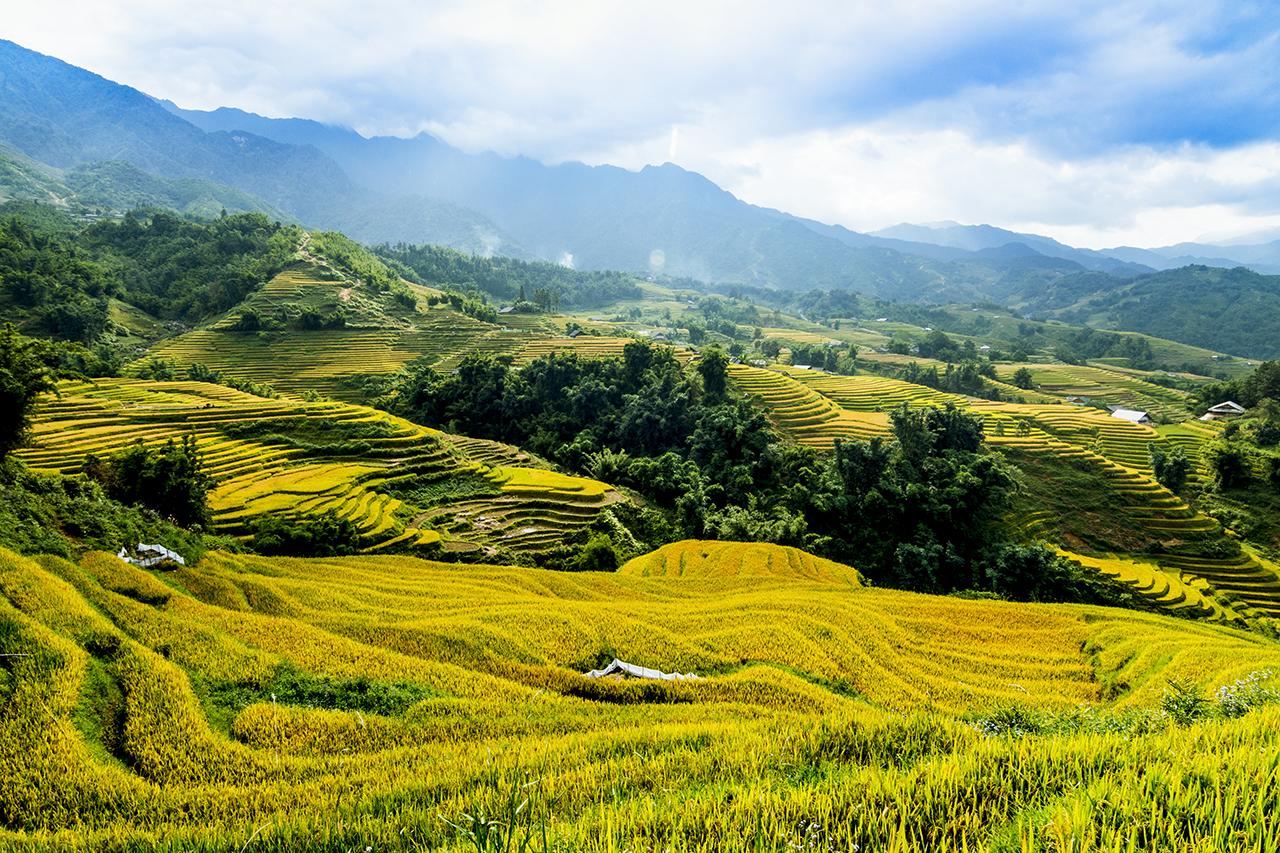
Rice terraces in Y Ty
Festivals and Helpful Travel Tips for Visitors to Vietnam in September
September presents an ideal time for tourists coming to Vietnam, not only for the pleasant weather conditions but also for a variety of activities and festivals to discover.
In Hanoi, the Mid-Autumn Festival, celebrated on the 15th day of the 8th lunar month (usually at the end of September), is a great time to learn about Vietnamese traditions surrounding this festival. During this time, the streets are filled with a festive atmosphere and lit up with colorful lanterns, toys for children and mooncake stalls. This festivity is particularly appreciated by families and offers a unique insight into local culture.
September is the low tourist time for both domestic and international markets, reflected in the reduced accommodation rates and many advantageous offers throughout the country.
Keep in mind that September 2 is a National Public Holiday in Vietnam, which leads to increased crowds at popular tourist attractions such as Sapa, Ninh Binh, and Hoi An. To avoid the crowds and maximize your travel experience, it is advisable to book in advance and opt for non-holiday days. This allows you to take full advantage of the peaceful atmosphere and the special promotions available during this period.
Alongside the main attractions in Vietnam, September also offers the opportunity to take part in a variety of local festivals. These cultural events offer a fascinating insight into traditional Vietnamese life, with artistic demonstrations, folk performances, and community festivities. For example, some festivals celebrate the rice harvest and agricultural culture, offering visitors an authentic insight into rural Vietnamese life.
Travel to Vietnam in October and November
In October and November, the north of Vietnam is in full autumn, temperatures remarkably drop after the hot summer months, and the rains gradually diminish, making it perfect for hiking in the mountains in Mai Chau, Pu Luong, and Ha Giang. The rice terraces and post-harvest farming activities in parts of the north-west reveal spectacular views for hikers and photographers.
October and November mark the height of the rainy season in central Vietnam. The abundant precipitation can lead to flooding; hence, it is essential to be flexible with travel schedules and follow the weather forecast. Despite the weather, this is still a great time to discover the rich culture and history of the fascinating cities in this part of the country.
Meanwhile, the dry season commences in the south, characterized by sunny days and low rainfall. This is the ideal time to enjoy the tranquil beaches and unspoiled islands such as Phu Quoc, Con Dao, and Mui Ne.
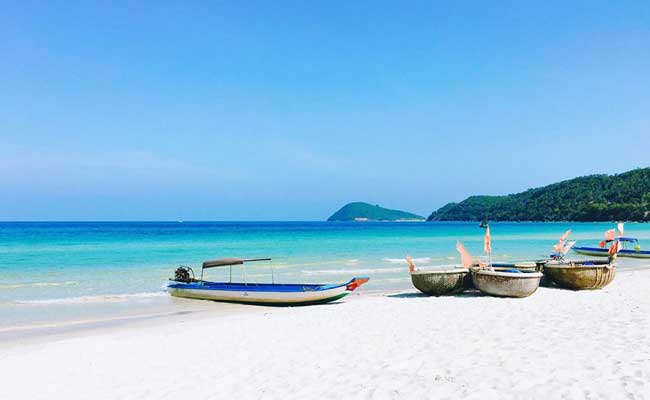
Phu Quoc Paradise
Festivals and cultural events
During October and November, Vietnam shines with a variety of festivals and cultural events that attract visitors from all over the world. These festivities not only offer a fascinating insight into Vietnamese culture but also enrich the travel experience for tourists.
Taken place in October, the Hoi An Festivalis a not-to-be-missed event that honors the rich heritage of this UNESCO World Heritage City. During the festival days, the streets come alive with colorful parades, traditional music performances, folk dancing, and culinary contests. Visitors who come to Hoi An at this time can explore the bustling night markets and take part in unique cultural ceremonies, such as the lantern lighting on the Thu Bon River.
Besides the principal festivals, October and November are times when many contemporary art events take place in Hanoi and Ho Chi Minh City. During this period, the Vietnamese cultural landscape is enriched by art exhibitions, concerts, dance, and theatre performances. Art lovers can visit short-lived galleries and artists’ studios for a full immersion in the vibrant art scene,
Helpful Travel Tips for Visitors to Vietnam in October and November
Considering the peak tourist season, it is highly recommended to book accommodation, guided tours, and tickets for special events in advance to make the most of these festivals and minimize the inconveniences. Central cities like Hue and Hoi An, for example, require extra preparation due to their unpredictable weather conditions, which are frequently impacted by typhoons and heavy rain. In contrast, North and South Vietnam generally offer more stable conditions for rewarding cultural and historical explorations. By carefully planning your trip to Vietnam for the months of October and November, you have the opportunity to enjoy a memorable and carefree travel experience.
Choice of destinations
Choose your destinations according to the weather forecast and the cultural events or attractions that you are interested in. For those who seek majestic mountainous landscapes and authentic local life of the minority ethnic groups, head for the northern region. As for those who prefer beaches, southern destinations such as Phu Quoc and Mui Ne provide ideal conditions for relaxing by the water.
Advanced Booking
Given Vietnam’s rising tourism demand in October and November, it is for the best that you finish booking in advance. Not only will this guarantee your place, but it will also help you avoid price increases and last-minute inconveniences.
Be prepared for the changing weather
Although the climate is generally favorable at this time of year, still, be prepared for possible weather changes, especially in central regions such as Huế and Hội An, where typhoons and heavy rain can occur. Make sure you have appropriate clothing ready and check the local weather forecast to adjust your itinerary if necessary.
Take part in local festivals
Enjoy the vibrant atmosphere of the local festivals that enliven Vietnamese towns and villages in October and November. From the Moon Festival in Hanoi to the Hội An Festival celebrations, these events offer a unique cultural immersion. Be sure to check the dates and plan accordingly to incorporate these enriching experiences into your itinerary.
Travel to Vietnam in December
December is an ideal time to discover the different facets of Vietnam, with optimal weather conditions across the country.
Northern Vietnam enters winter in December. The temperatures fluctuate between 15 and 20 degrees Celsius, with days that are sometimes sunny and sometimes cloudier. With low rainfall, this time is ideal for exploring historic sites such as the Ho Chi Minh Mausoleum in Hanoi and the magnificent landscapes of Sapa.
Central Vietnam experiences a significant drop in rainfall in December, marking the end of the rainy season. Historic towns like Hue and Hoi An are perfect to visit during this period, as the pleasant temperatures favor exploring ancient alleys and cultural monuments.
The South continues into the dry season in December, with warm, sunny days and very little rain. The magnificent beaches of the south coast, such as Con Dao, Phu Quoc and Mui Ne, are prime destinations for those looking to relax by the water and enjoy water sports activities.
Where to visit in Vietnam in December?
December is certainly a perfect time to visit Vietnam, owing to the ideal weather conditions allowing tourists to discover each region of the country from North to South. In northeastern regions such as Mai Chau and Pu Luong, trekking enthusiasts will be in for a treat, given the picturesque hiking routes through authentic ethnic villages where humans and nature harmoniously cohabit.
Vietnam’s seaside beaches, especially Con Dao, Phu Quoc, and Mui Ne, are particularly attractive in December. Featuring turquoise waters and fine sandy shores, these beaches are perfect for relaxing in the mild sunshine and enjoying a quiet seaside getaway. These destinations also boast unique opportunities for diving, snorkeling, and other water-based activities, enriching the experience for travelers looking for relaxation and adventure by the water.
Cruising through the majestic Hạ Long Bay is a must-do experience in December. Sunny days illuminate the bay's striking rock formations, creating a breathtaking seascape. Trips like these allow visitors to explore hidden caves, paddle through tranquil lagoons, and discover the teeming marine life of this World Heritage-listed area.
Festival and Helpful Travel Tips for visitors to Vietnam in December
In December, Vietnam is decked out for the peak tourist season, marked by the Christmas and New Year festivities, attracting an influx of visitors from all over the country:
In Ha Long and popular southern coastal destinations such as Con Dao, Phu Quoc and Mui Ne, hotels regularly host lavish gala dinners to celebrate Christmas in a uniquely tropical atmosphere. To guarantee your spot and benefit from the best deals, it is strongly recommended that you book your accommodation and flight tickets as soon as possible.
For adventure-seekers and trekking enthusiasts exploring the North, particularly the mountainous regions such as Sapa and the Northeast, it is essential to bring warm clothing suitable for winter conditions. During this time of the year, temperatures can drop dramatically, creating spectacular landscapes of rice terraces and remote ethnic villages. Prepare yourself for unique experiences as you discover these majestic panoramas while taking care of your thermal comfort to make the most of each hike.
By carefully planning your trip to Vietnam in December and following these recommendations, you can fully savor all the wonders Vietnam has to offer. Explore the diversity of landscapes, from the mountains of the north to the beaches of the south, and take part in lively festivals for a full immersion in the local culture. Plan early to avoid last-minute inconveniences and allow yourself to be dazzled by the beauty and cultural richness of this fascinating country, no matter what your choice of activity or destination.
FAQs
Can I visit Vietnam during the rainy season?
While it's possible to visit Vietnam during the rainy season, especially in the central and southern regions, be prepared for sporadic downpours and potential travel disruptions.
Are there any precautions to take during the Tet Festival?
Many businesses close during this time, so it's essential to plan and book accommodations as well as transportation in advance.
What should I pack for a trip to Vietnam?
Lightweight, breathable clothing, comfortable walking shoes, insect repellent, and a rain jacket or umbrella are essential items to pack, irrespective of the season.
Is it safe to eat street food in Vietnam?
Street food is an essential part of Vietnamese culture. It's best to choose busy vendors with high turnover to ensure the freshness and quality of the food.
What are some off-the-beaten-path destinations in Vietnam?
Consider exploring the mountainous region of Ha Giang, the karst landscapes of Ninh Binh, or the remote island of Con Dao for an authentic and less-touristed experience.
Vietnam presents an incredible variety of experiences throughout the year, with each season delivering its own set of wonders to discover. Whether you're drawn to the spellbinding landscapes of the North, the paradise-like beaches of the South, or the vibrant cultural festivities, there's always something extraordinary to discover. Hence, the best time to travel to Vietnam depends on your personal preferences and what you want to experience in Vietnam. For personalized advice on the best time to go, contact us now at: sales@authentiktravel.com.
We are here to help you decide when to go to Vietnam and to plan an unforgettable trip, meeting all your expectations and providing memorable moments every step of the way.
Related articles:
>> Vietnam Tour 2024-2025: Where to go? Which itinerary? What to do? How many days?
>> Vietnam itinerary + seaside stay in Vietnam
>> Vietnam tour 15 days: What to do? What itinerary ideas do you have?
>> Vietnam tour 14 days, what to visit in Vietnam in 2 weeks?
>> Tour 1 week in Vietnam: Good deals for a 7-day tour in Vietnam
>> 3 Weeks in Vietnam: List of the Best 21-Day Travel Itineraries
Dear Ritesh, depend on your plan and the region you want to travel, it can be all year around. But, I think the best time to go to Vietnam is February to April. This is the most beautiful period for you to explore all over the country.
 Español
Español Français
Français






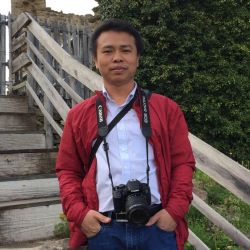

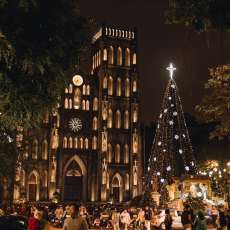
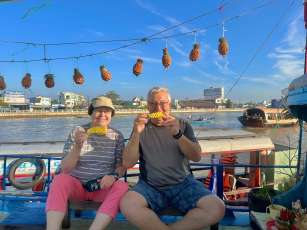
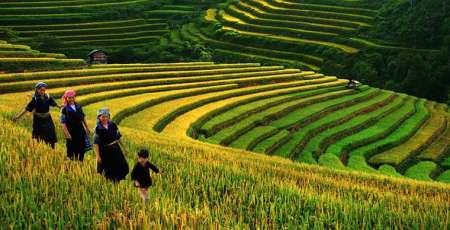
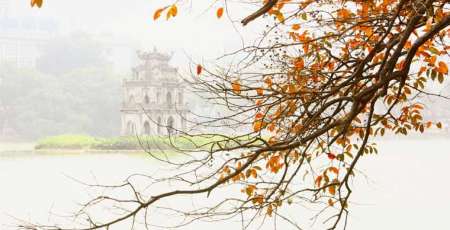
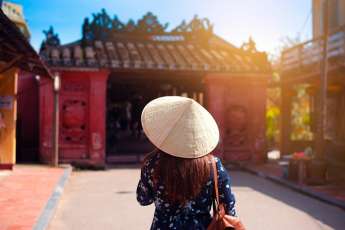
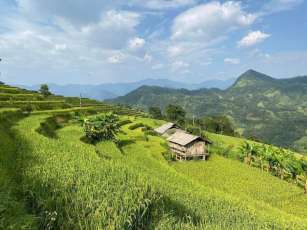







Morgane Ter Cock
on Dec 18, 2025HerbertPhomaMS
on Oct 19, 2025Lilyan Cuttler
on Oct 15, 2025Avenue17XC
on Sep 14, 2025Avenue18JL
on Jul 21, 2025